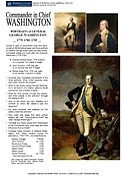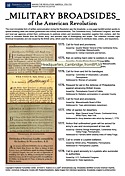WAR: 1775-1783
3. Leading the War
- Correspondence of George Washington as Commander in Chief, 1775-1778, selections PDF
- Portraits of George Washington as Commander in Chief, 1779, 1780, 1785
 PDF
PDF - Military broadsides of the Revolution, 1775-1778, selection PDF



Gen. George Washington, 1 January 1777
Initially reluctant to accept the office of Commander in Chief of the Continental Army in 1775, Washington quickly devoted himself to building the army from scratch, sustaining it through defeat and hardship, and leading it to ultimate victory. Not a career military man, Washington had left the army sixteen years earlier after serving as an officer in the French and Indian War. To leave his Virginia plantation and family at age forty-three to lead a makeshift army against the imperial forces of Britain required traits that Washington proved, to the surprise of some, that he could summon in the darkest hours. He also exhibited a remarkable flexibility. As Washington "strove to create a conventional army," historian Robert Middlekauff points out, "he proved himself capable of departing from standard doctrine. He campaigned in the winter; he used irregulars—as the militias surely were; he appealed to political principles and to the nation; and he did not attempt to confine the war to a few men of his class and to the dregs of society."1 With ardor, self-sacrifice, a temper when he needed it, an astonishing attention to detail (necessitated by his army's lack of experienced officers), and a firm devotion to the "glorious cause," Washington fairly earned the title "Father of His Country."
Correspondence of George Washington as Commander in Chief, 1775-1778, selections. What does it mean to be Commander in Chief? What duties and decisions are unique to the top military leader in a war? What ultimate responsibilities fall on the commander's desk? A close view is afforded by these selections from George Washington's correspondence during the first half of the Revolutionary War, from his appointment as Commander in Chief in June 1775 through the brutal winter of 1777-78 at Valley Forge, Pennsylvania, to his strategic victory with a revitalized army at Monmouth, New Jersey, in June 1778. Read these excerpts not as a history of the war years but as a sampling of the life-and-death issues and the myriad of routine details that are the charge of a Commander in Chief. (14 pp.)
Portraits of George Washington as Commander in Chief, 1779, 1780, 1785.
 How did portrait painters depict the revered General Washington during and after the war? Here we view three portraits of Washington by the noted artists Charles Willson Peale, John Trumbull, and Robert Edge Pine. Peale and Trumbull—both of whom served with Washington—portray a triumphant, stalwart, almost cocky Washington, while Pine presents us with the retired Washington who has returned home to Mount Vernon—permanently, he hoped. How could one argue that each portrait reveals the "real" George Washington? the "real" Commander in Chief? (4 pp.)
How did portrait painters depict the revered General Washington during and after the war? Here we view three portraits of Washington by the noted artists Charles Willson Peale, John Trumbull, and Robert Edge Pine. Peale and Trumbull—both of whom served with Washington—portray a triumphant, stalwart, almost cocky Washington, while Pine presents us with the retired Washington who has returned home to Mount Vernon—permanently, he hoped. How could one argue that each portrait reveals the "real" George Washington? the "real" Commander in Chief? (4 pp.)Military broadsides of the Revolution, 1775-1778, selection. The most immediate form of written communication during the Revolution was the broadside—a one-page handbill printed quickly to distribute news and information throughout a community. In the hundreds they were issued by Gen. Washington, other commanders, the Continental Congress, and state and local agencies in order to requisition supplies from civilians, alert the public to imminent threats, publicize orders and resolutions, and proclaim days of thanksgiving and prayer. This collection includes eight American broadsides and one issued by the British army. In what ways do they resemble modern "instant" communications? In what ways are they emphatically eighteenth-century documents? (Compare these broadsides with the news broadsides in #5: Reporting the War). (10 pp.)
Discussion Questions
- From Washington's correspondence, what overall impression do you develop of his qualities as a military commander? as a person and family member?
- What was his greatest military concern as Commander in Chief, in your estimation? Why?
- What was his greatest personal concern as Commander in Chief? What leads you to your conclusion?
- Complete the table below with examples from Washington's military correspondence. When complete, select one entry as the most crucial issue facing Washington during the war and explain your selection.
Duties & Issues related to maintaining an army and its soldiers' commitment Duties & Issues related to military strategy & tactics (winning the war) Personal/family concerns as Commander in Chief Applicable to commanders in all wars Specific to the American Revolution Specific to Gen. George Washington - Did completing the table above change your answers to questions #2 & #3? If so, why?
- What change is evident in Washington's attitude toward his decision to lead the Continental Army?
- Characterize the orders issued by Washington regarding such issues as health and hygiene, religious observance, discipline and punishments, camp provisions, battle plans, etc. When does he encourage, and when does he command?
- When and why does Washington offer monetary rewards to the troops? Would you agree or disagree with his decision?
- What other examples do you find of Washington's flexibility in applying standard military doctrine to the struggling Continental Army, as noted by historian Robert Middlekauff?
- How did Washington address the troops and the Continental Congress after a victory? after a defeat?
- Why do you think Washington gave detailed instructions and measurements for the construction of soldiers' "huts" during winter quarters? What evidence can you cite from his correspondence? (His officers would understand his specificity without explanation.)
- Compare the three portraits of George Washington. When was each painted? How does each artist place objects and other persons in the scene to enhance the total effect of the portrait?
- Which is your favorite? Why?
- Artists John Trumbull and Charles Willson Peale served with Washington in the war. How might their experience have influenced their portraits?
- How could one argue that each portrait presents the "real" George Washington? the "real" Commander in Chief?
- Compare the military portraits of Washington with later portraits of him before his presidency (see CONSTITUTION #7), and as president (1789-1797).
- What do the military broadsides reveal about the day-by-day military challenges of the American Revolution?
- What strategies of military command (and flexibility) do they reveal?
- How do they serve as "advertisements" as well as military announcements?
- How do they use font, layout, and language to convey information quickly and effectively? How are some broadsides more effective than others?
- In what ways do they resemble modern "instant" communications? In what ways are they emphatically eighteenth-century documents?
- Rewrite one broadside as a "breaking news" e-mail, a blog entry, a pop-up web window, a tweet, or a similar online communication. Does the transformation work? Why or why not?
Framing Questions
- How did Patriot leadership—military, diplomatic, and governmental—promote and hinder the war effort?
- How did the war affect Patriots, Loyalists, Indians, African Americans, and women? How were power relationships changed?
- How were decisions by Britain and France critical to the outcome of the war?
- Was victory the last achievement of the thirteen colonies or the first achievement of the new nation?
Printing
Correspondence of Washington as Commander in ChiefPortraits of Washington as Commander in Chief
Military broadsides of the Revolution
TOTAL
14 pp.
4 pp.
10 pp.
28 pp.
Supplemental Sites
- – Biography (White House)
- – Biography (Mount Vernon)
- – Rare Facts & Curious Truths (Mount Vernon)
- – George Washington Wired (blog, Mount Vernon)
- – Timeline (Papers of George Washington, Library of Congress)
- – FAQ (Papers of George Washington, University of Virginia)
- – Soldier-Statesman (U.S. Army)
- – Creating a Continental Army (14 documents)
- – Revolutionary War: Northern Front, 1775-1777 (14 documents)
- – Revolutionary War: The Turning Point, 1777-1778 (13 documents)
- – Revolutionary War: Southern Phase, 1778-1781 (14 documents)
- – Revolutionary War: The Home Front (13 documents)
- – Revolutionary War: Groping Toward Peace, 1781-1783 (13 documents)
- – War Timeline (Washington's Life)
- – Portraits of George Washington by John Trumbull and others
- – George and Martha Washington: Portrait from the Presidential Years (National Portrait Gallery)
Washington's Physical Appearance in Portraits (New York Public Library)
William Lee: George Washington's Valet (Mount Vernon)
Artcyclopedia, art works online "Was the American Revolution Inevitable?," not-to-miss teachable essay by Prof. Francis D. Cogliano, University of Edinburgh (BBC)
Teaching the Revolution, valuable overview essay by Prof. Carol Berkin, Baruch College (CUNY)
General Online Resources
1Robert Middlekauff, The Glorious Cause: The American Revolution, 1763-1789 (Oxford University Press, 1982; paperback ed., 1985), p. 301.
Images:
– Portrait of George Washington by John Trumbull, oil on canvas, 1780. Metropolitan Museum of Art, New York; bequest of Charles Allen Munn, 1924 (24.109.88); www.metmuseum.org/toah/works-of-art/24.109.88. Reproduced by permission.
– Call for food and provisions issued by the Massachusetts Board of War, addressed to town officials [written in hand, "Westborough"], broadside, 3 February 1777. Reproduced by permission of the American Antiquarian Society.
– Announcement to farmers issued by General George Washington, Valley Forge, Pennsylvania, broadside, 20 December 1777. Reproduced by permission of the Historical Society of Pennsylvania.
Banner image: John Trumbull, Surrender of Lord Cornwallis, oil on canvas, 1820 (detail). Courtesy of the U.S. Capitol, Office of the Architect of the Capitol.
*PDF file - You will need software on your computer that allows you to read and print Portable Document Format (PDF) files, such as Adobe Acrobat Reader. If you do not have this software, you may download it FREE from Adobe's Web site.



